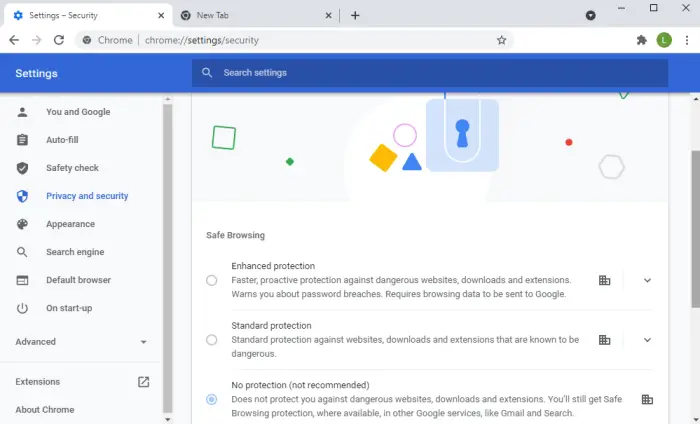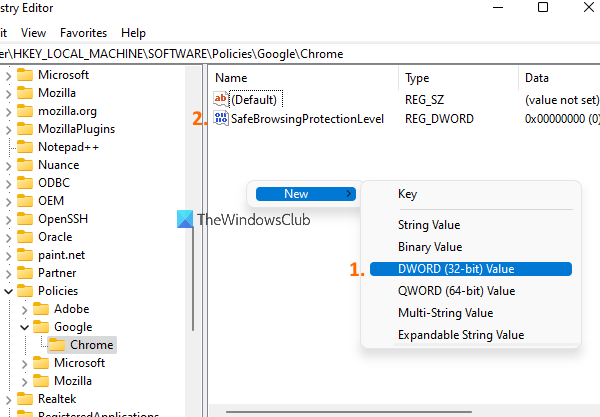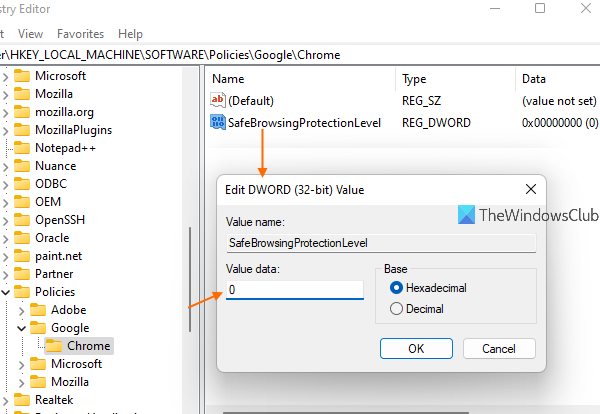In this post, we will help you with how to enable or disable Safe Browsing in Chrome browser on Windows 11/10 computers. By default, Safe Browsing remains enabled in Google Chrome with Standard protection, and you can also turn on Enhanced Protection of this feature. If you have to disable Safe Browsing for some reason, then you can use the step-by-step instructions covered in this post to edit the Windows Registry. You can also enable Safe Browsing whenever needed.

What is Safe Browsing in Google Chrome?
Safe Browsing is a built-in feature of Google Chrome that helps you protect from dangerous extensions, sites, downloads, etc. It is different from private browsing or incognito mode. As mentioned earlier, it comes with two main protection levels known as Standard protection and Enhanced protection.
For each protection level, there are different security features like it warns you if passwords are exposed in some data breach, checks unsafe sites from the database stored in Chrome, predicts and warns you about dangerous events, and more. A No protection level is also there which doesn’t protect you while accessing dangerous sites, etc., but you will still get Safe Browsing security wherever available.
Enable or Disable Safe Browsing in Google Chrome using REGEDIT in Windows 11
Whether you have to enable or disable Safe Browsing in Chrome browser, it requires a simple Registry tweak on Windows 11/10 PC. Before using this or any Registry tweak, it is also advised to create a system restore point, just in case. Now follow these steps:
- Open Registry Editor window
- Access Policies key
- Create Google key under Policies key
- Create Chrome key under Google key
- Create SafeBrowsingProtectionLevel DWORD value
- Change Value data of SafeBrowsingProtectionLevel value
- Restart Chrome browser.
Open the Registry Editor window. You can type regedit in the Search box of your Windows 11/10 computer and press the Enter key to open it. Or else, you can use some other preferred way to open it.
After opening Registry Editor, access the Policies key. The path is:
HKEY_LOCAL_MACHINE\SOFTWARE\Policies

Under Policies key, create a Registry key, and set its name to Google. Once you have done that, create another Registry key under Google key, and rename it as Chrome.

Now, on the right-hand part of the Chrome key, you need to create a new DWORD value. For that, right-click on the empty area, click on New, and click on the DWORD (32-bit) Value option. Once it is done, rename that DWORD value to SafeBrowsingProtectionLevel.

Double-click on the SafeBrowsingProtectionLevel key and a small box will open. There you have to change its Value data. You can add these three values:
- 0 for No Protection
- 1 for Standard protection
- 2 for Enhanced protection.

Add 0 in the Value data field to disable Safe browsing and press OK.
Now you can close Registry Editor. After that, restart the Chrome browser if it is opened already. When you will access the Safe Browsing section under Settings of Chrome browser, you will notice that it is disabled now. Both of its options (Standard Protection and Enhanced Protection) will be disabled/greyed out, and No protection option will be selected automatically.
To enable Safe Browsing again in Google Chrome, follow the steps mentioned above and access SafeBrowsingProtectionLevel DWORD value. After that, just delete that DWORD value, and restart the Chrome browser.
Note: A similar setting was also available in the Local Group Policy feature of Windows 11/10 for Google Chrome, but that setting is deprecated. Therefore, the Registry Editor method is handy.
How do I remove safe browsing?
If you are looking for a way to disable Safe Browsing for Chrome browser, then you can follow the steps explained here. The same trick can be used to re-enable Safe Browsing in Google Chrome. The Registry method works but the Group Policy has been deprecated.
Read: Google Chrome warnings in browser explained.
Where do I find Safe Browsing in Chrome?
Safe Browsing feature is present under the Settings of Google Chrome. To access it, use these steps:
- Click on the three vertical dots icon present on the top-right part of the Chrome browser
- Click on the Settings option
- Select Privacy and security option available on the left section
- Click on the Security section available on the right part.
I hope it helps.
Read next: How safe is Private Browsing?
Leave a Reply